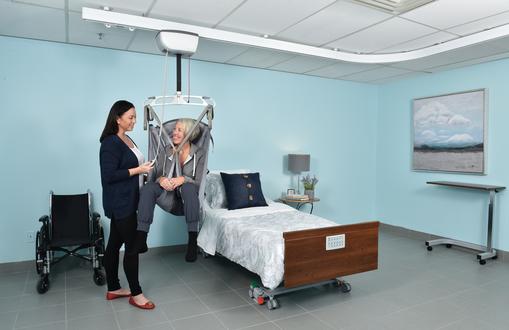Creating a home environment that accommodates the needs of individuals with mobility challenges is essential for ensuring comfort, safety, and independence. One of the most effective solutions for enhancing accessibility in the home is the installation of a handicap ceiling lift system. These systems offer a practical and efficient way to assist individuals in moving between different areas of their homes, providing both convenience and security. In this blog, we’ll explore the benefits of handicap ceiling lift systems, how they work, and key considerations when choosing and installing ceiling lifts for homes.
The Benefits of Handicap Ceiling Lift Systems
Handicap ceiling lift systems are designed to assist individuals with mobility challenges in moving from one location to another with ease. Here’s why they are highly valued:
Enhanced Mobility and Independence
One of the primary benefits of a handicap ceiling lift system is the increased mobility and independence it provides. For individuals who have difficulty getting out of bed, walking, or moving, a ceiling lift allows them to transition smoothly between different areas of their home, such as from a bed to a wheelchair or from a wheelchair to a bathroom. This reduces the need for manual assistance and promotes greater self-sufficiency.
Reduced Risk of Injury
Ceiling lift systems help mitigate the risk of injury for both the user and caregivers. By using a lift to move individuals, the risk of falls, strains, or other accidents is significantly reduced. This is particularly important for caregivers who might otherwise need to physically lift or transfer individuals, which can be physically demanding.
Versatility and Convenience
Handicap ceiling lifts offer versatility and convenience by allowing users to move effortlessly between different areas of the home. Whether transitioning from a bedroom to a living area or from a wheelchair to a shower, the ceiling lift system can accommodate various needs. This convenience can greatly improve the quality of life and daily living experience.
Space Efficiency
Ceiling lifts are installed above head height, which means they do not take up valuable floor space. This makes them ideal for homes with limited space or those where maintaining an open floor plan is important. The system’s discreet installation ensures that living areas remain unobstructed.
Customizable and Expandable
Many handicap ceiling lift systems are customizable to fit the specific layout and needs of a home. They can be designed to cover various distances and configurations, and some systems can be expanded or reconfigured as needs change. This adaptability ensures that the lift system remains effective as circumstances evolve.
How Handicap Ceiling Lift Systems Work
A handicap ceiling lift system typically consists of several key components:
Ceiling Track
The ceiling track is the primary component of the lift system, mounted securely to the ceiling. This track supports the lift and provides a path for it to travel along. It can be configured in various layouts, including straight, curved, or even complex multi-directional tracks, depending on the needs of the home.
Lift Unit
The lift unit is the motorized component that moves along the ceiling track. It is equipped with a lifting mechanism that raises and lowers a user or their mobility device. The lift unit is controlled via a remote or pendant control, allowing users or caregivers to operate the lift with ease.
Lift Sling or Carrier
The sling or carrier is the part of the system that supports the user. It is attached to the lift unit and provides a safe and comfortable way to move individuals. Slings come in various sizes and styles to accommodate different needs and preferences.
Control System
The control system allows users or caregivers to operate the lift unit. This can include a remote control, pendant, or wall-mounted controls. Some systems offer advanced features, such as programmable settings or voice activation, for added convenience.
Installation and Safety Features
Proper installation is imperative for the safety and effectiveness of the ceiling lift system. Professional installers like ours ensure the system is securely mounted and operates correctly. Safety features, such as load sensors, emergency stop buttons, and safety straps, are also integrated to prevent accidents and ensure reliable operation.
Choosing the Right Handicap Ceiling Lift System for Your Home
When selecting a handicap ceiling lift system for your home, consider the following factors to ensure you choose the best option:
Assess Your Needs
Evaluate the user’s specific needs and the layout of your home. Consider factors such as the distance the lift needs to travel, the weight capacity required, and any special requirements, such as transferring between specific rooms or handling multiple users.
Consult with a Professional
Consulting with a professional who specializes in ceiling lift systems can provide valuable insights and recommendations. They can assess your home’s layout, discuss your needs, and help design a system that meets your requirements. Professional advice ensures that the lift system is installed correctly and functions optimally.
Consider the Layout
The layout of your home will influence the design of the ceiling track system. Straight tracks are suitable for simple, linear movements, while curved or multi-directional tracks are needed for more complex layouts. Consider the space available and how the lift system will integrate with your home’s design.
Evaluate Features and Options
Explore the features and options available for ceiling lift systems. Some systems offer advanced controls, programmable settings, or additional safety features. Before your purchase, determine which features are important for your needs and budget.
Check for Warranty and Support
Ensure that the ceiling lift system comes with a warranty and access to support services. A warranty gives you peace of mind in case of any issues with the equipment, while support services can assist with maintenance and repairs.
Installing and Using Your Handicap Ceiling Lift System
Once you’ve selected and purchased your ceiling lift system, proper installation and usage are essential for maximizing its benefits:
Professional Installation
Professional installation is recommended to make sure the system is mounted securely and operates correctly. Installers will handle the setup, including mounting the track, installing the lift unit, and configuring the control system.
Follow Usage Instructions
Carefully review and follow the manufacturer’s usage instructions for the lift system. This includes operating the controls, using the sling or carrier, and performing routine maintenance.
Perform Regular Maintenance
Regular maintenance is important to ensure the lift system remains in good working condition. Inspect the track, lift unit, and sling for any signs of wear or damage. Schedule periodic maintenance checks with a professional to address any issues.
Train Users and Caregivers
Ensure that all users and caregivers are properly trained on how to operate the ceiling lift system. This includes understanding how to use the controls, position the sling, and perform any necessary safety checks.
Conclusion
A handicap ceiling lift system offers a practical and efficient solution for enhancing accessibility and mobility within the home. By providing safe and convenient movement between different areas, ceiling lifts improve the quality of life for individuals with mobility challenges and reduce the physical strain on caregivers. When exploring options for handicap ceiling lifts for homes, consider factors such as layout, features, and professional installation to ensure you select the best system for your needs. With the right ceiling lift system, you can create a more accessible living environment, promoting greater independence and ease of movement for everyone in the home.


Recent Comments